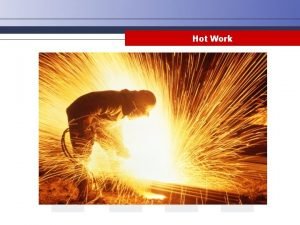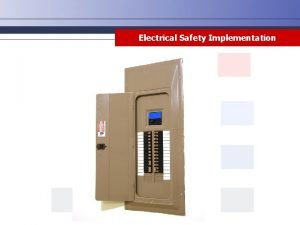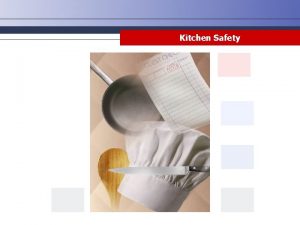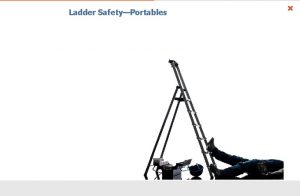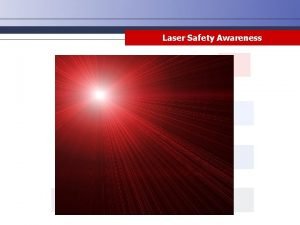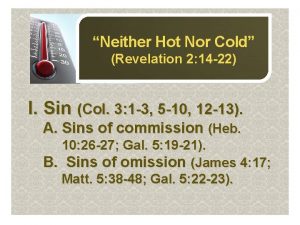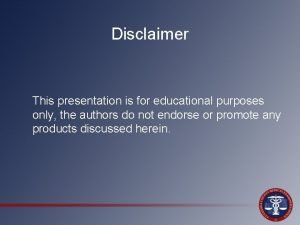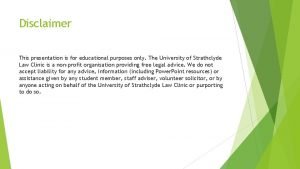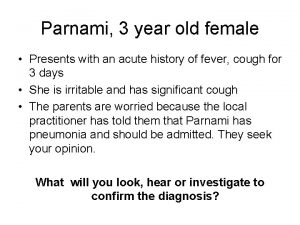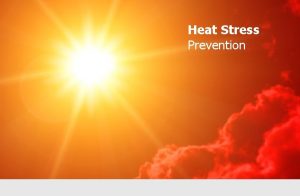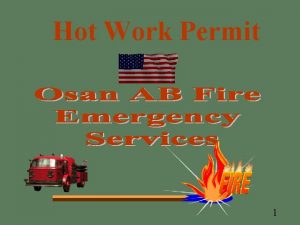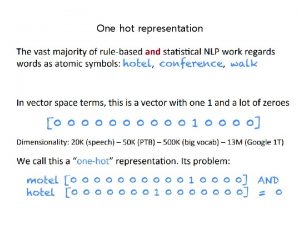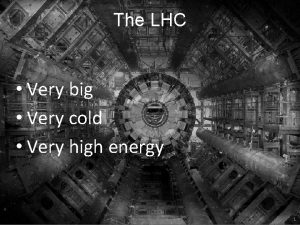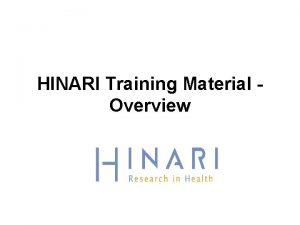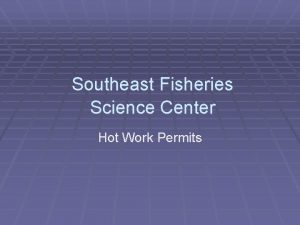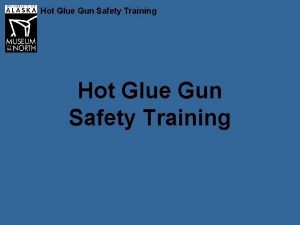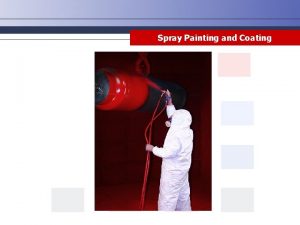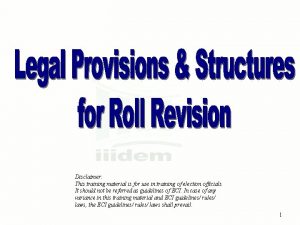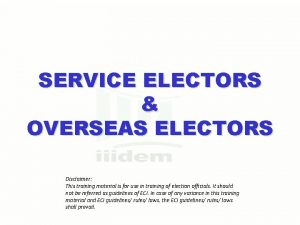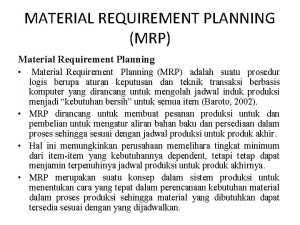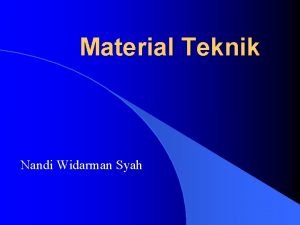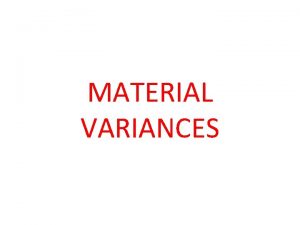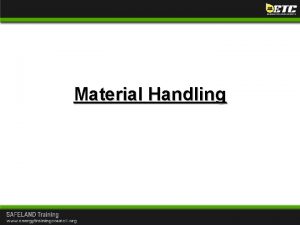Hot Work Disclaimer This training material presents very









































- Slides: 41

Hot Work

Disclaimer • This training material presents very important information. • Your organization must do an evaluation of all exposures, applicable codes and regulations, and establish proper controls, training, and protective measures to effectively control exposures and assure compliance. • This program is neither a determination that the conditions and practices of your organization are safe nor a warranty that reliance upon this program will prevent accidents and losses or satisfy local, state or federal regulations. • All procedures and training, whether required by law or not, should be implemented and reviewed by safety and risk management professionals, and legal counsel to ensure that all local, state and federal requirements are satisfied.

Course Outline – Hot Work 1. Why Take Hot Work Training? 2. Hot Work Defined 3. Pre Hot Work Requirements 4. Personal Protective Equipment 5. Welding Operations 6. Torch Cutting Operations 7. Brazing 8. Cylinder Handling 9. Cable Requirements 10. Documentation Requirements 11. Well Site Ignition 12. Summary

Why Take Hot Work Training? This training module will present best practice awareness on proper hot work procedures. • Hot work incidents are one of the most common causes of fires in the workplace. • Safe work environments have less employee injuries and worker compensation claims. • Safe work environments are less costly and can help organizations avoid OSHA citations. • A quality hot work program in the workplace will help to establish safe hot work practices to reduce/eliminate personal injury, and potential fire and explosion hazards.

Hot Work Defined What is Hot Work? • The term “Hot Work” applies to any work environment where hot work is conducted in an area that is not designated and designed to prevent fires or other hazards associated with this work. • Hot work can be performed in many work environments. Some examples include: – Construction sites – Machine shops – Maintenance sites – Laboratories

Hot Work Defined There are safety risks inherent in hot work: • Welding, cutting, and brazing pose unique safety and health risks. • Four deaths per thousand workers occur over a working lifetime. • Welding, cutting, and brazing is addressed in specific standards for general industry, shipyard employment, marine terminals, and the construction industry.

Hot Work Defined Types of hot work: Some processes become hot work when conducted in the vicinity of flammable materials, others are classified as hot work regardless. These include tasks such as: • Welding • Torch cutting • Brazing • Grinding

Pre Hot Work Requirements Make necessary preparations: • Hazard Assessment: Perform a Hazard Assessment to establish needed controls and Personal Protective Equipment (PPE). • Notification: Notify area management and co-workers of the intention to perform hot work activities. • Permitting: Issue hot work permits for all hot work operations (the Risk Management Center has example permits that can be used). • Housekeeping: Perform housekeeping in hot work areas to remove and/or cover all combustible or flammable materials.

Pre Hot Work Requirements Fire prevention preparations: • Have proper fire extinguishing equipment in the immediate area. • Require that at least one 10 pound ABC fire extinguisher is available at each hot work location and area affected. • Cover all wood planking, scaffolds, wooden forms, and other combustible materials that cannot be removed, with fire blankets or other suitable noncombustible material to contain slag and sparks. • Provide a fire watch when performing hot work in areas where fires might develop. Continue the watch for at least 60 minutes after completion of hot work.

Pre Hot Work Requirements Required engineering controls: • Welding curtains: Position welding • Disposal tools: Provide metal buckets • Gases and vapors: Check for curtains to protect workers from welding arc rays. or containers for disposal of slag, electrode stubs, and other hot work debris. flammable or explosive gases or vapors and, if necessary, purge and/or inert the atmosphere before any hot work in or on containers or pipelines. Refer to “Confined Space Entry” for ventilation and other requirements for hot work in confined spaces.

Personal Protection Equipment (PPE) Eye protection: The following PPE is essential for hot work operations and needs to be used in accordance with a prepared Hazard Assessment: • Proper eye protection: Examples: Welding hood • Safety glasses: These must be worn under hoods with proper shaded lens, cutting or burning goggles for torch cutting, full face shields for grinding with safety glasses. and face shields when grinding. The Job Hazard Analysis application in the Risk Management Center can assist in training as well as completing and documenting, your Hazard Assessments.

Personal Protection Equipment (PPE) Eye protection - shading: • Shading: Proper shading of the eye • Shade numbers: They range from 3 to 14. • Proper selection: Shade numbers are • Examples: Protection is afforded with a protection is critical to assure protection. Higher numbers mean greater protection. selected based on a Hazard Assessment performed for the task. selected shade number for hazards ranging from glare of reflected sunlight; acetylene cutting and welding; electric spot welding; and arc cutting and welding.

Personal Protection Equipment (PPE) Body, hand foot protection: • Wear appropriate gloves for the type of hot work task being performed. • Wear fire resistant welding jackets and leathers. • Wear high top leather boots that are tight to the pant leg. • Wear clothing that is free of oil and grease, and is made from nonsynthetic fiber.

Welding Operations Pre-welding requirements: • Electrode holders: Only use electrode • Insulation: It is required that electrode • Worker protection: Remove electrodes holders that are specifically designed for arc cutting and welding and are of a sufficient capacity to safely handle the maximum rated current required by the electrodes. holders be properly insulated. from the holders and placeholders so they cannot make contact with people or conducting objects when leaving holders unattended.

Welding Operations Pre-welding requirements (continued): • Grounding: It is required that the • Proper shut off: Shut off the welding machine frame be properly grounded. Welding units store electrical current! welding machine at the end of each shift or when the machine is to be moved. Follow the lockout program and only work on equipment if properly trained, and authorized by the organization.

Torch Cutting Operation Pre-torch cutting requirements: • Pre-inspection: Inspect torches and hoses at the beginning of each shift • Lockout/tagout: Tag defective torches and remove from service until • Regulators and valves: Ensure that oxygen and fuel gas regulators and for leaking shutoff valves, damaged hoses and couplings, and tip connections. properly repaired. valves be in proper working order, shut off when done working with them and hose pressure relieved.

Torch Cutting Operation Pre-torch cutting requirements (continued): • Proper lighting: Light torches with strikers or other approved • Cylinders and fittings: Keep oxygen cylinders and fittings free of oil • Do not interchange hoses: Oxygen and fuel gas hoses need to be • Flashback: Provide flashback arrestors/check valves on all oxygen • Taping: Do not cover more than 4 inches out of 12 inches (10 cm means, never with matches or lighters. and grease. easily distinguishable from each other and are not interchangeable. Do not use a single hose having more than one gas passage. and fuel gas torches. Remove hose that shows evidence of flashback or damage from service and repair or discard. out of 30 cm) of hose with tape when taping parallel lengths of hose to prevent tangling.

Torch Cutting Operation Pre-torch cutting requirements (continued): • Hose couplings: Use only hose couplings that • Hose positioning: String hoses overhead • Safe shut off: Shut off cylinder valves, bleed • Hose storage: It is required that the boxes cannot be unlocked or disconnected by means of a straight pull. using non-metallic hangers or otherwise position them to keep clear of walkways, ladders, and stairways; as well as to prevent their damage. regulators and hoses when done with a task and never leave unattended. used to store hose be ventilated.

Torch Cutting Operation Pre-torch cutting requirements (continued): • Air quality: Provide proper ventilation and • Personal Protective Equipment (PPE): Do a respiratory equipment when cutting zinc coated, or other hazardous coating or alloy that could contain such materials as cadmium, chromium, mercury, lead, arsenic or other toxic material (See “Respiratory Protection”). pre-assessment as needed to determine hazards and a Hazard Assessment to specify needed protective measures and PPE.

Brazing Pre-brazing requirements: • Hazard awareness: Hazards • Hazard Assessment: This must exist from the gases and fumes that can be emitted, ultraviolet and infrared rays that require properly shaded eye protection, heat and debris that can be released. be completed prior to the job to specify needed protective measures and PPE, and equipment safety. Note: Need for additional PPE

Brazing Safe brazing: • Adjacent workers: The Hazard Assessment needs to address adjacent • Screens or shields: These must be set to protect staff and need to be workers or other persons in the vicinity of the brazing (and all hot work) operations. configured so as not to impede ventilation.

Brazing Safe brazing (continued): • Hand protection: Leather heat • Respiratory protection: Ensure resistant gloves are needed to provide safety to your hands and arms. that excellent local exhaust ventilation is in place to address fumes such as from burning fluxes, brazing pastes, powders, coatings, and metals.

Cylinder Handling Hazard Communication training: • Training: All staff must be current in their Hazard Communication training requirements. • Safety Data Sheet (SDS): A manufacturer’s statement of origin is required for all chemicals. Employees understand the physical and health hazards associated. • PPE requirements: Use the SDS and your organization’s Hazard Assessment to correctly obtain and use required PPE.

Cylinder Handling Proper cylinder identification: • Use tags: Ensure that tags are used indicating, full, in use, or empty. • Labels: Ensure that all cylinders are marked with labels with either the chemical or trade name, and hazards of the contents, and that a current Safety Data Sheet (SDS) is on hand.

Cylinder Handling Proper cylinder identification (continued): • Signage: Provide proper signs at storage areas, e. g. , "Danger- Flammable. No Sources of Ignition, Smoking or Open Flames. ” • Capped and tagged: Storage locations must be stored with caps on, • Empty cylinders: The empty fuel or gas cylinders shall have their tagged, and in locations where they will not be damaged by passing or falling objects, and access controlled to authorized and trained persons. valves closed, capped, and tagged as empty.

Cylinder Handling Valve safety: • Connection: Stand to the side of the • Storing preparation: Remove regulators • Prior to moving: Close valves, remove outlet and open valve slightly and close immediately prior to connecting a regulator to a cylinder. Never crack a valve near ignition sources. and replace valve safety caps when storing cylinders or when cylinders will be left unattended. regulators, and replace valve safety caps before moving cylinders.

Cylinder Handling Cylinder movement: • Authorized access: Only authorized and trained staff are to handle the cylinders. • Know what is in the cylinders: Be absolutely sure you know what the materials are in the cylinders. • Moving cylinders: Only move cylinders with cart designed for this purpose and assure the cylinders are chained and secure, and in designated pathways.

Cylinder Handling Storage locations: • SDS requirements: Store cylinders in • Ventilation: Cylinders need to be • Clean storage area: Keep storage accordance with SDS instructions and local, state and federal requirements. Do not store in a location where they will be subjected to sources of heat. stored in well-ventilated, protected, and dry locations designated for this purpose. areas free of vegetation, trash, and other combustible materials. Never take gas cylinders into confined spaces!

Cylinder Handling Incompatible cylinder storage: • Separation: Oxygen cylinders must be separated from fuel gas cylinders and combustible materials by at least 20 feet, or by a non-combustible barrier at least five feet high having a fire resistance rating of at least one-half hour.

Cylinder Handling Incompatible cylinder storage (continued): • Minimum distance of 20 feet: From combustible materials and away • Gases such as pyrophoric and dopant gases: Some gases require from stairs, aisle ways, and elevators. special storage requirements that may include bunkers and/or secondary containment and ventilated cabinets. • Combustible materials: Combustibles like oil and grease are not to be placed near the gas cylinders. • Reserve gas cylinders: Keep away from the use area in designated storage areas.

Cylinder Handling basics: • Upright: Secure cylinders in an upright position at all times. • Improper uses: Never use cylinders as rollers or supports, whether empty or full.

Cylinder Handling basics (continued): • Carts: − Provide bottle carts, chains, or other steadying devices to keep cylinders from being knocked over while in use. − Move cylinders by use of a cylinder cart with securing device. − Never lay cylinders on their sides and never “hand-roll” them. • Handle or wrench: Require all cylinders to be equipped with a handle or wrench so that they can be turned off immediately if necessary. • Safe positioning of cylinders: Set up where they will not be struck by sparks, slag, or flame, and where they cannot become part of an electrical circuit.

Cylinder Handling Do not: • Use acetylene at a pressure in excess of 15 -psi gauge pressure, or 30 psi absolute. • Use hammers or wrenches to open cylinders having fixed hand wheels. • Strike an electrode against a cylinder to strike an arc. • Attempt to refill or mix gases in a cylinder. • Use magnets, chokers, or slings to hoist cylinders. (Instead, use a cradle or bottle rack designed and constructed for hoisting purposes).

Cable Requirements Welding/cutting/ground cables must meet the following requirements: • Be completely insulated, flexible, and capable of handling the maximum current requirements of the work in progress. • Be free from repair or splices for a minimum distance of 10 feet from the electrode holder, except when standard insulated connectors or splices with insulating value equal to the cable are used. • Have insulated connectors of a capacity at least equal to that of the cable which shall be used for splices. – If connecting lugs are used, they must be completely and substantially insulated.

Cable Requirements Welding/cutting/ground cables must meet the following requirements (continued): • A ground cable must have a safe current carrying capacity at least equal to the maximum output capacity of the unit or units that it services. • Never attach a ground cable to a pipeline containing gases or flammable liquids. • String all cables overhead with non-metallic hangers or otherwise position to keep clear of walkways, ladders, and stairways. • Immediately remove all damaged and worn cables from service until properly repaired.

Documentation Requirements Documentation requirements: • The Training Tracking application of the Risk Management Center is to be used for documenting all training. • All incident investigations involving near misses or incidents are to be documented using the Incident Track application of the Risk Management Center. All classes, worker briefings, tool box briefings, audit result briefings and incident investigation briefings involving near misses or incidents are to be documented. • • Hot work permits are to be retained for one year in the Risk Management Center.

Well Site Ignition Sources of well site ignition: Oil and gas well sites present unique hazards with hot work due to the presence of flammable and combustible gases, vapors, and liquids. Following are some potential sources of ignition on drill sites which must be controlled to prevent hazards of fire and explosion: • • Welding, cutting, brazing, and grinding Any open flames Smoking Power tools Internal combustion engine sparks Vehicles with catalytic converters Two-way radios Generators

Well Site Ignition Preventative measures: • Pre-plan and perform a Hazard Assessment. • Remove all spark and open flame sources far away from the work area. • Prohibit smoking and post signs. • Internal combustion engines require spark arrestors. • Vehicles with catalytic converters are prohibited from the area and rig.

Summary Hot work basic facts: • • Hot work can be performed in many work environments. • Four deaths per thousand workers occur over a working lifetime. Hot work may include welding, cutting, and brazing and can pose unique safety and health risks. Preparation is key to preventing incidents: • Perform a Hazard Assessment to establish needed controls and Personal Protective Equipment (PPE) based on tasks being performed. • Notify area management and co-workers of the intention to perform hot work activities. • Issue hot work permits for all hot work operations. The Risk Management Center has example permits to use.

Summary Preparation is key to preventing incidents (continued): • Perform housekeeping in hot work areas to remove and/or cover all combustible or flammable materials. • Cover all wood planking, scaffolds, wooden forms, and other combustible material that cannot be removed with fire blankets or other suitable non-combustible material to contain slag and sparks. • Provide a fire watch when performing hot work in areas where fires might develop. Continue the watch for at least 60 minutes after completion of hot work. • Have proper fire extinguishing equipment in the immediate area.

Hot Work This form documents that the training specified above was presented to the listed participants. By signing below, each participant acknowledges receiving this training. Organization: Trainer: Trainer’s Signature: Class Participants: Name: Signature: Date: Name: Signature: Date: Name: Signature: Date: Remember to load your completed trainings into the Risk Management Center.
 Disclaimer for training material
Disclaimer for training material Disclaimer for training material
Disclaimer for training material Disclaimer for training material
Disclaimer for training material Ladder ratings
Ladder ratings Disclaimer for training material
Disclaimer for training material What is tragedy
What is tragedy Figure 10
Figure 10 Multiplication of scientific notation
Multiplication of scientific notation Few fewfewf
Few fewfewf Receiving table/area
Receiving table/area Quantifiers for milk
Quantifiers for milk What is question tags and examples?
What is question tags and examples? White hot vs red hot temperature
White hot vs red hot temperature Cold working and hot working
Cold working and hot working Perbedaan hot lava dan hot lava volcano
Perbedaan hot lava dan hot lava volcano Be either hot or cold
Be either hot or cold Educational purposes only disclaimer example
Educational purposes only disclaimer example For educational purposes only disclaimer
For educational purposes only disclaimer Gd&t symbol
Gd&t symbol Usage variance formula
Usage variance formula Ethnocentrism examples
Ethnocentrism examples Refers to the knowledge language values customs
Refers to the knowledge language values customs All groups create norms to enforce their cultural values.
All groups create norms to enforce their cultural values. What is harmful and useful
What is harmful and useful Presents cause and effect relationships
Presents cause and effect relationships Presents from my aunt in pakistan
Presents from my aunt in pakistan Pear paragraph example
Pear paragraph example Sally elatta presents on business agility
Sally elatta presents on business agility 16 3 darwin presents his case answer key
16 3 darwin presents his case answer key Section 15-3 darwin presents his case
Section 15-3 darwin presents his case Sats word problems
Sats word problems Sue palmer skeletons
Sue palmer skeletons Zids and zods
Zids and zods Prose writing that presents and explains ideas
Prose writing that presents and explains ideas Prose writing that presents and explains ideas
Prose writing that presents and explains ideas Zids and zods
Zids and zods Where does “snowflake girl” help to deliver presents
Where does “snowflake girl” help to deliver presents Mot de bienvenue au culte d'adoration
Mot de bienvenue au culte d'adoration Which statement presents the main idea of the text
Which statement presents the main idea of the text A 26 year old female presents
A 26 year old female presents This presents
This presents Name and define the four narrative essentials of a play
Name and define the four narrative essentials of a play
